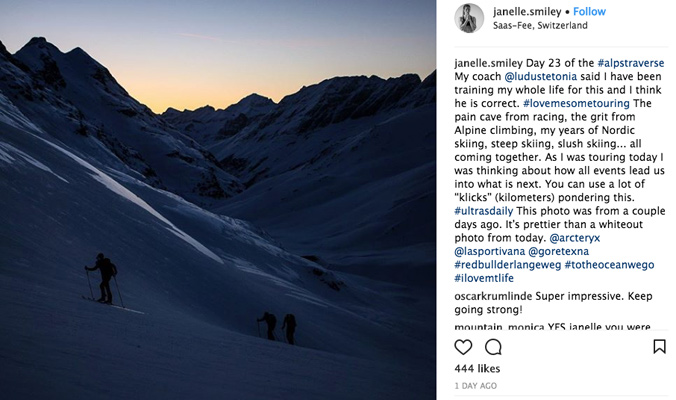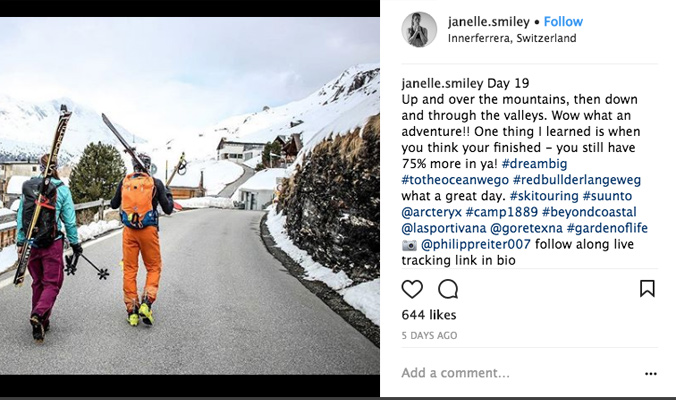On March 17, a team of seven athletes from around the globe set off to recreate a traverse in the European Alps from Vienna, Austria to Nice, France—an expedition first completed in 1971 by Austrian mountaineers Robert Kittl, Klaus Hoi, Hansjörg Farbmacher and Hans Mariacher.
The event, called Der Lange Weg, is the brainchild of mountain guide Heli Putz and covers a massive 2,000 kilometers in 41 days—a feat not attempted since the first tour nearly 50 years ago. Putz handpicked the seven athletes who are currently en route to Nice, including Jackson Hole, Wyo.-based husband-and-wife duo Mark Smiley, an AMGA Guide, and Janelle Smiley, an Exum Mountain Guide and skimo champion.
To learn more about their expedition, we caught up with the Smileys before they left for Europe.

Day 20 saw Janelle Smiley still going strong. Photo: Courtesy Janelle Smiley via Instagram
Backcountry Magazine: How have you been preparing for this expedition?
Janelle Smiley: Usually in years past with my skimo racing, I go out for an hour or two with a very specific interval speed and prescribed work. But with training for this, I just get to go out and be outside on my feet for seven to 10 hours. So just being able to travel in the mountains and get a bunch of vert and mileage in—it’s a dream for me, and I haven’t even started the event.
BCM: How did you get involved with this?
JS: In 2012, [Heli Putz] came up with an event idea called the Waymaker—also the name of an Atomic boot they were trying to promote. In this event there were six teams, and they went from point A to B, but they had to pick their own route based on how rowdy the terrain was and how much vert or distance they wanted to cover. Mark, my husband, did it with two Canadians, and they ended up winning the event, because they picked this gnarly line and got a bunch of photos for documentation. And Mark is a mountain guide, so he had a leg up with terrain management.
For Der Lange Weg, Heli Putz and Mark were chatting back and forth, and Putz asked him what he thought about traversing the Alps. He also asked Mark what other Americans would be good to invite along, and Mark said I would be a good candidate as a mountaineer and racer—so that’s how I got on the team. And then Putz put together the rest of the team.
Mark Smiley: Putz is a big idea guy, and he has this energy around him, so I thought, “Well if he thinks we can do it, we can do it.” Initially, I thought he wanted me to assemble my own team, and I was thinking about what friends I have who would make a good team, who could take a month and a half off and have the mountain sense and the physical ability and the interest. When you pass people through that many filters, there really aren’t a lot of choices. Even I have wondered if I want to hurt for that long, but it is the definition of adventure—to pit yourself against something you’re not sure you can do.
And the pioneers of this route have already done it, so I see this expedition as a way to add flair to the route with different equipment, and we’ll probably change the route a little bit. But we’re going to go the same amount of vertical feet and kilometers. Based on that, we’re just trying to recreate the original expedition, just a bit faster.
BCM: Will this trip be supported?
JS: We’re going to have a little camper van that will come around and meet us, just like the first party did. So every day, we’ll only have to carry daypacks, and we go up and over mountains and meet our little van. There are some sections where we’ll stay in hut winter rooms, but we’ll usually come back to our camper van.
BCM: Is time a factor?
JS: This is kind of a timed expedition, and we’re just trying to learn how modern technology affects whether or not we will be able to do this traverse faster than the original group did it in 1971. In one way, technology is an asset, and in another, it’s a deficit. Back then they didn’t have avalanche forecasting, so these guys just went wherever they wanted. If we were to travel into an area with the avalanche hazard at a four or five on the European avy scale, it would be irresponsible of us. That’s one challenge I foresee. But we have more advanced navigation tools, so we’ll spend less time being lost and wandering around in the mountains.

In her most recent Instagram post from the field, Smiley thanks her years of competition for her ability to push through the challenge of Der Lange Weg. [Photo] Courtesy Janelle Smiley via Instagram
BCM: What do you think about the team component?
JS: I don’t know. We flew over to Austria to meet the team, and we’ve never skied with a lot of these people. We did a two-hour tour with a few of them, but nothing longer. As far as taking a selection of high-powered endurance athletes and putting them together as a team, I’m hoping it goes smoothly. In the first group, there were military men and mountain guides. The dynamic is different when you bring together mountain guides and elite athletes.
BCM: Are you going to go about your avy safety differently on this trip than you do in your day-to-day life as guides?
JS: We spent a lot of time going over the original group’s maps, and we’re making A, B and C options. Ideally we’ll stick to a plan, but we’ll give ourselves options so we can keep moving even if weather conditions are not as we’d like. But I think a lot of it is going to have to be an on-the-fly decision. Any one day in this trip is not unusual in my skiing life, but to take those days and stack them on top of each other is going to be challenging. Skiing for 41 days in a row is going to be an interesting mental and physical challenge.
BCM: What do you think the average vert will be each day?
JS: They’re saying between 7- to 8,000-vert per day, which is not unusual for me, but the mileage will be different than what I’m used to. We’re looking to cover between 30 to 50 miles per day. We were thinking 30 percent is up, 30 percent is down and then the remaining 40 percent is kind of flat. And moving with a party of seven in the mountains, trying to cover that much ground, it’s going to be difficult.
The skill sets are all very different too. We’re supposed to start and finish together, but I have a feeling we’ll split into multiple groups during the day to keep things more manageable.

Along the route, the team traverses not only the Alps, but also its villages. [Photo] Courtesy Janelle Smiley via Instagram
BCM: What are you going to do for food?
JS: Well, I’m hoping I don’t develop diabetes from the amount of sugar I’m going to have to consume. We’re still trying to work that out. I’m going to be eating a lot of nut butters, but any time you do something for that long, you have to change things up. We’ll bring stuff from the U.S., but I think we’ll end up eating a lot of sausage and cheese.
BCM: How are you going to pace this?
MS: It’s all about your heart rate and your percentage of your max heart rate. So the way I think of it is Zone One is walking to the mailbox; Zone Two is strolling up the road with a friend where you can carry on a conversation the whole time; Zone Three is one sentence at a time; Zone Four is one word at a time between breaths; and Zone Five, by definition, you can’t keep for more than a minute—you’re sprinting. And I think we’re going to have to stay in Zone Two and Three the whole time. But what I don’t know is if it’s better to stay in high Zone Three for eight hours, or if we should stay in Zone Two be outside for 11 hours. Everyone on the team is crazy strong, and three of the other guys have way bigger engines than I have, and I’m nervous about that—I don’t want to be the slow guy.
April 10 Update: Team member Tamara Lunger had to drop out of the event due to an overuse injury, but the Smileys are still going strong on day 25. See the group’s Instagram updates at redbull.com, Janelle Smileys updates on Instagram at @janelle.smiley and Mark’s updates at @smileysproject.










Related posts: